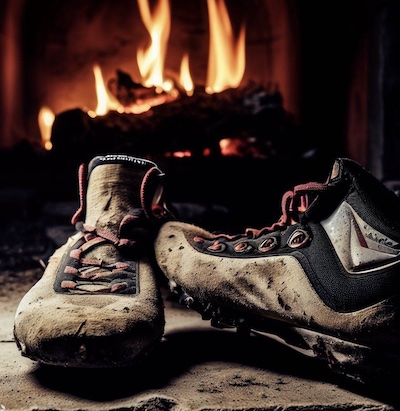
Howdy, partners! If you’re a fan of the Wild West style and own a pair of rugged cowboy boots, you know that keeping them clean and pristine is essential to maintain that classic look. Whether you’ve been two-stepping on the dance floor or herding cattle, your boots have probably seen their fair share of dirt, dust, and mud. But fear not; I’m here to guide you through cleaning your beloved leather companions. This article’ll delve into the art of cleaning cowboy boots, from removing stubborn stains to applying the right conditioner to keep that leather luscious.
Preparing Your Boots for Cleaning
Dusting off the Dirt and Mud
Before you dive into the cleaning process, give your boots a good shake to rid them of loose dirt and debris. This initial step helps prevent scratching the leather when you start scrubbing. For the stubborn bits stuck in the crevices, use a soft brush with bristles that won’t harm the leather.
Tackling Tough Stains
If your cowboy boots have encountered more than just ordinary dust, it’s time to roll up your sleeves and tackle those tough stains. Grab a damp cloth, ensure it’s not dripping wet, and gently blot the stained areas. Avoid rubbing vigorously, which could push the stain deeper into the leather. Instead, use a light touch and let the cloth do the work.
Choosing the Right Cleaning Solution
When cleaning your boots, opt for a mild, leather-friendly cleaner. Avoid harsh chemicals that could strip the leather of its natural oils. You can find specialized leather cleaners at your local store or online. Apply a small amount to a clean, damp cloth and test it on a less visible spot of your boot to ensure it doesn’t discolor the leather.
Softening and Conditioning
After cleaning, it’s time to condition your cowboy boots to keep the leather supple and prevent cracking. Choose a lanolin-based leather conditioner for the best results. Apply a small amount onto a dry cloth and gently massage it into the leather using circular motions. This will help restore moisture and give your boots a healthy shine.
Letting Your Boots Dry Naturally
Once you’ve applied the conditioner, allow your boots to dry naturally. Avoid placing them near direct heat sources like radiators or heaters, as this can cause the leather to become brittle. Instead, place them in a well-ventilated area at room temperature. For extra shape retention, consider using a boot tree to maintain their form while they dry.
The Final Touch: Polishing Your Boots
When your boots are dry and rejuvenated, give them the finishing touch by applying a leather polish. Choose a color that matches your boots and apply a thin, even layer using a clean cloth. Allow the polish to absorb for a few minutes, and then buff your boots using a separate dry cloth until they gleam.
Cleaning and Caring for Your Cowboy Boots
Removing Lingering Dirt and Grime
Now that your boots are prepped, it’s time to roll up those sleeves and get into the nitty-gritty of cleaning. Take a soft-bristled brush and dip it in a mixture of mild soap and warm water. Gently scrub the entire surface of your boots, paying extra attention to any stubborn spots. Remember, a gentle touch goes a long way in preserving the leather’s integrity.
Wiping Away Excess Soap
After scrubbing, grab a clean, damp cloth and wipe away the soap residue. Remove all traces of soap, as leftover residue can dull the leather’s shine over time. Give your boots a quick once-over to ensure they’re squeaky clean.
Drying Safely and Thoroughly
Once your boots are cleaned, it’s time to let them dry again. This time, however, ensure they’re completely dry before moving on to the next step. You can gently pat them down with a dry cloth, absorbing any excess moisture. Allow them to air dry in a cool, shaded area. Patience is critical here – rushing the drying process can lead to warped leather.
Applying the Leather Conditioner
Remember that lanolin-based leather conditioner we mentioned earlier? It’s time to bring it back into action. Apply a small amount to a clean, dry cloth and gently rub it onto your boots in circular motions. The conditioner not only adds a beautiful lustre but also helps protect the leather from the elements.
Buffing and Polishing
After applying the conditioner, give your boots a gentle buff using a separate, dry cloth. This will help distribute the conditioner evenly and give your boots a natural shine. If you aim for extra shine, consider using a horsehair brush to polish the leather. This step’s extra effort can make your boots stand out.
Final Touches and Boot Care Tips
As your boots regain their lustre, take a moment to inspect them closely. If you spot any areas that need more attention, repeat the cleaning and conditioning process. Taking your time and ensuring every inch is treated with care is better.
Storing Your Boots
Once your boots are gleaming, it’s essential to store them properly. Use a boot tree to help maintain their shape while in storage. Avoid keeping them in damp or humid environments, which can encourage mold growth. Instead, store them in a cool, dry place away from direct sunlight.
Regular Maintenance is Key
Remember, the key to long-lasting cowboy boots is regular maintenance. Clean and condition them every few months, even if they haven’t been subjected to intense dirt. This routine care will ensure that your boots remain as stunning as the day you first pulled them on.
Partner, you’ve now mastered the art of cleaning and caring for your cowboy boots. Following these steps and adopting a proactive approach to boot care’ll keep your favorite footwear looking sharp and stylish for years. So go ahead, wear your newly cleaned boots, and hit the trails with a confident stride. And remember to stay tuned for more tips and insights right here on our running shoe tips and reviews website. Until next time, happy booting!


